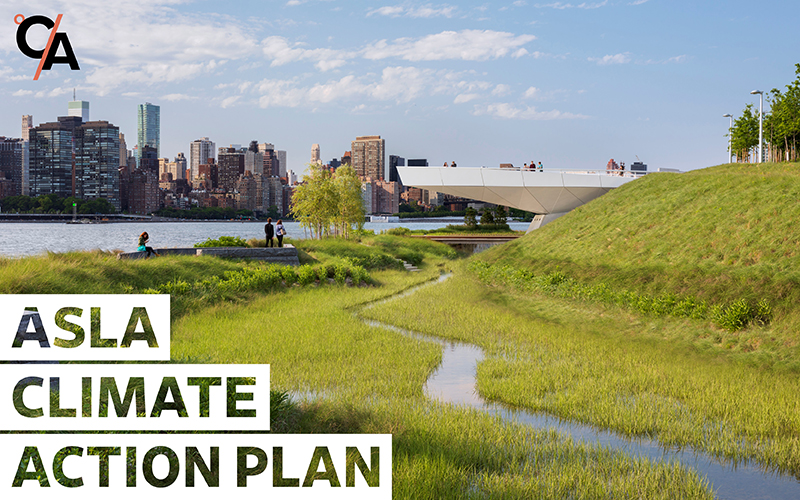The American Society of Landscape Architects (ASLA) Announces New Industry-wide Benchmarks to Address Climate Change and Biodiversity Crises
 ASLA 2019 Professional General Design Honor Award. Hunter's Point South Waterfront Park Phase II: A New Urban Ecology. Long Island City, NY. SWA/BALSLEY and WEISS/MANFREDI with ARUP / copyright Vecerka/ESTO, courtesy SWA/BALSLEY and WEISS/MANFREDI
ASLA 2019 Professional General Design Honor Award. Hunter's Point South Waterfront Park Phase II: A New Urban Ecology. Long Island City, NY. SWA/BALSLEY and WEISS/MANFREDI with ARUP / copyright Vecerka/ESTO, courtesy SWA/BALSLEY and WEISS/MANFREDI The American Society of Landscape Architects (ASLA) announced today that it has set new goals for the profession. Together the ASLA Climate Action Plan and the Climate Action Field Guide for ASLA Members chart a pathway for landscape architects to achieve zero greenhouse gas emissions in their projects and operations and increase carbon sequestration by 2040.
The Climate Action Plan was developed by a high-profile Task Force of five landscape architects chaired by Pamela Conrad, ASLA, founder of Climate Positive Design, and a 17-member Advisory Group. It outlines a bold vision for 2040 and a set of 71 actions to be taken by 2025.
By 2040, all landscape architecture projects will simultaneously:
- Achieve zero embodied and operational emissions and increase carbon sequestration
- Provide significant economic benefits in the form of measurable ecosystem services, health co-benefits, sequestration, and green jobs
- Address climate injustices, empower communities, and increase equitable distribution of climate investments
- Restore ecosystems and increase and protect biodiversity
“Landscape architects are already helping communities achieve this vision. As we increasingly experience the impacts of the climate and biodiversity crises, we know we need to act faster. We are the only design professionals who bring all the pieces together to plan and design what communities need to prepare themselves for a changing world,” said ASLA President Eugenia Martin, FASLA.
“ASLA has developed its first Climate Action Plan in the spirit of great optimism. We envision communities becoming healthier and economically stronger because they have committed to drawing down carbon, restoring ecosystems and increasing biodiversity, and reducing reliance on vehicles – all while ensuring everyone in their community has equitable access to these benefits,” said ASLA CEO Torey Carter-Conneen.
The ASLA Climate Action Plan is based in science. The Intergovernmental Panel on Climate Change (IPCC) has found humanity can only put a maximum of 340 more gigatons of greenhouse gas emissions into the atmosphere if we want a good chance of only increasing temperatures by 1.5° C (2.7° Fahrenheit), instead of 2° C (3.6° Fahrenheit). To advance the goal of keeping warming to 1.5° C, ASLA signed on to the International Federation of Landscape Architects (IFLA) Climate Action Commitment in 2021. The commitment was presented at the UN Framework Convention on Climate Change (UNFCCC) COP26 in Glasgow, Scotland and is supported by 70,000 landscape architects in 77 countries.
The ASLA Climate Action Plan is rooted in the three goals (practice, equity, and advocacy) and six initiatives of IFLA Climate Action Commitment.
The ASLA plan will direct all ASLA programs and investments through 2025. Goals will be advanced through 21 objectives and 71 actions. Goals and actions will be revisited and updated in 2025 and every five years until 2040 and beyond.
To accomplish the plan, ASLA, as a non-profit association, has also committed to achieving zero emissions in its operations by 2040. ASLA is calculating baseline Scope 1, 2, and 3 emissions for its 2022 Conference on Landscape Architecture in San Francisco and headquarters operations in Washington, D.C. and has committed to reducing its overall emissions by 20% by 2024. ASLA will use its own journey to zero as a learning opportunity for its members, EXPO exhibitors, and partner organizations.
A companion to the plan – the Climate Action Field Guide for ASLA Members – provides best practice guidance, toolkits, and resources for ASLA members and their firms and organizations, along with corporate partners, to achieve the 2040 vision.
The Field Guide features six toolkits covering 18 strategies, with guidance on how to:
- Design Climate Positive Landscapes
- Design Pedestrian, Cyclist, and Public Transit-Centric Communities
- Reduce Energy Use and Support Renewables
- Help Communities Adapt to Climate Impacts
- Explore Pathways to Financial Sustainability with Communities
- Protect and Increase Biodiversity
- Learn from Indigenous Communities Through Collaboration
- Build Climate Coalitions
“Landscape architects are uniquely qualified to understand and manage complex, multi-disciplinary challenges and design sustainable, world-changing solutions. We are committed to following the science, and through this Climate Action Plan we will rapidly scale up Climate- and Biodiversity-positive solutions in the U.S. and, through our partnership with IFLA, the world,” said Pamela Conrad, ASLA, Chair of the Climate Action Plan Task Force.
Conrad will represent ASLA and highlight the vision and goals of the ASLA Climate Action Plan at the United Nations Framework Convention on Climate Change (UNFCCC) COP27 in Sharm El-Sheikh, Egypt.